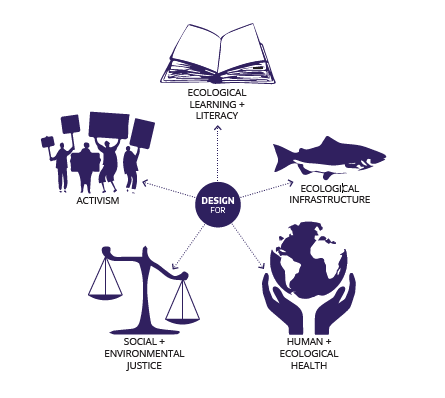Urban Ecological Design is a design practice that is socially, ecologically, and aesthetically engaging with aims to improve ecological functioning, preserve and generate resources for human use, and foster more resilient approaches to design and management of our built environments. Urban Ecological Design has emerged as a critical issue for cities and urbanizing regions in the 21st century, and for more than 15 years the University of Washington’s Department of Landscape Architecture has committed to leading an interdisciplinary approach to explore, examine and further Urban Ecological Design through our research, teaching and service in the following key areas that are both distinctive and inherently integrated:

Environmental degradation and social inequity are defining issues of our time. The rapid decline of ecological systems and climate change have already begun to take their toll. Resource-poor communities are becoming increasingly vulnerable to natural disaster and disease. By 2050, more than 3 billion people may live in extreme poverty and more than 2 billion people may live in urban slums. We consider these challenges an undeniable call to action and believe in the potential of design as a powerful agent of social and environment justice.
By framing design as activism we take a critical stance relative to the exploitive systems of power that shape society and the environment. Working in Seattle and in cities worldwide, we pursue teaching, research, practice, and advocacy that foster fluid dialogue between theory, grounded action, and spatial intervention and that prioritize the aspirations of disenfranchised populations. Collaborating with diverse stakeholders and across disciplines, we champion landscape architecture as a participatory, synthetic and creative approach to problem solving that alters perceptions, unearths hidden potentials, instigates meaningful change and enables those without a voice to take possession of their own future.
Read more about how our department engages in design activism.
The field of urban ecology has emerged as an interwoven study and approach to understanding and designing contemporary cities. This represents a fundamental change in the priorities for urban infrastructure, although it continues to encompass the early 20th century urban goals of enhancing the health, safety and welfare of humans. Working at multiple scales, ecological infrastructure incorporates stormwater treatment, capture and re-use; street design for conviviality and multi-modal movement; low-impact transportation networks and facilities; habitat networks; and park, urban food, and greenway systems.
We focus on applying landscape ecology and conservation biology, as well as human preferences and behaviors, to the strategic design of multifunctional urban infrastructure. We look for ways to structure and guide the flows of organisms, materials, and energy that pass through a city in ways that support the characteristic biodiversity of a region, and that contribute to a thriving urban culture, using both innovative technological inventions and time-tested approaches.
Effective urban ecological design draws from and enriches ecological and cultural processes in a place, such that it enables ecological learning and literacy. Such literacy involves understanding the complexity of living systems, from which an ethic of valuing what Aldo Leopold called the “land community” develops.
As David Orr writes, ecological literacy cannot be developed entirely in abstract but requires direct experiences of and access to natural environments. Ecological literacy is essential for all citizens whose opportunities to experience natural environments are increasingly challenged.
To design for ecological learning and literacy, we aim to understand the myriad ecological and cultural systems at work in a site and its context; creatively integrate these systems through the designed forms, spaces and materials; and communicate the vitality and relationships of systems in compelling and aesthetic ways. We learn from the conditions of the place and from and with the people who connect with this place throughout the design process. The resulting design addresses opportunities for learning in multiple ways, and through diverse experiences over time.
Human and environmental health and well-being are inextricably related. Our focus on environmental design and planning investigates, practices and values effective strategies for preserving and advancing the health and well-being of humans and ecosystems at all scales—local, regional and global—within the long tradition of landscape architecture.
We collaborate with diverse communities from schools and neighborhoods to healthcare providers and patients to address these challenges through community planning, restorative design, environmental justice, and inquiries into the role of nature in therapeutic design. We work with public agencies and citizen groups to define policies and practices that would increase the sustainability of healthy communities. We value a synthesis of design and research within an interdisciplinary framework that engages the scholarship and practice of allied fields including environmental psychology, natural sciences, public health, medicine, social work and nursing.
Our program is dedicated to working for the greater good and achieving a better future for all communities. At the core of our mission is a commitment to social and environmental justice.
Our approach to both research and design is rooted in a sense that all people share a common humanity and therefore have a right to equitable treatment and equal access to vibrant, healthy environments and robust social policies and programs. This is expressed in a wide range of endeavors from the historical recovery of marginalized voices, to prioritizing access to healthy green spaces for all, to advocating for urban regeneration projects that champion the rights and value of poor communities of color.
By emphasizing social and environmental justice in our teaching, research, design and practice we foster a relational intelligence that values diversity, challenges injustice and is deeply thoughtful about the way we engage with others in our work. We strive to address the pressing needs of marginalized communities as a way to achieve restorative justice, and we train students to be leaders in landscape architecture so that they can be an influential force of positive community change locally and globally.